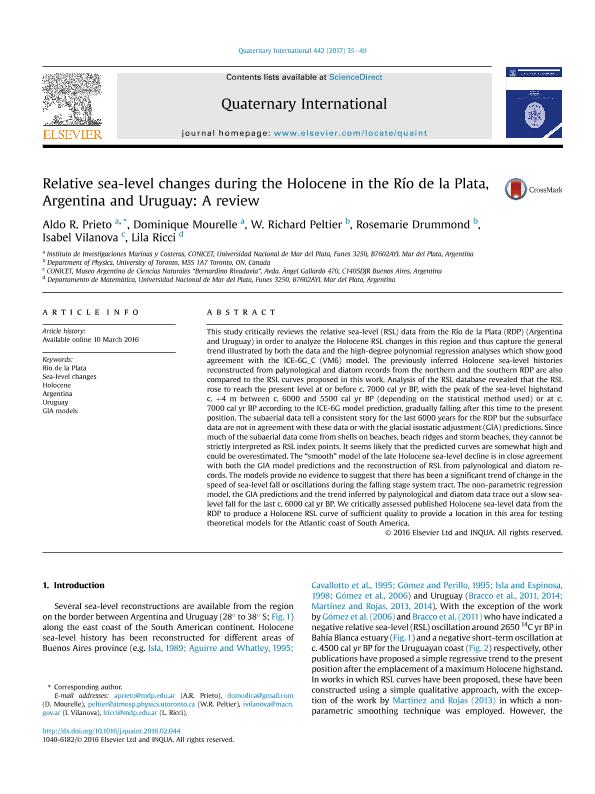Artículo
Relative sea-level changes during the Holocene in the Río de la Plata, Argentina and Uruguay: A review
Prieto, Aldo Raul ; Mourelle Civano, Dominique
; Mourelle Civano, Dominique ; Peltier, W. Richard; Drummond, Rosemarie; Vilanova, Isabel
; Peltier, W. Richard; Drummond, Rosemarie; Vilanova, Isabel ; Ricci, Lila
; Ricci, Lila
 ; Mourelle Civano, Dominique
; Mourelle Civano, Dominique ; Peltier, W. Richard; Drummond, Rosemarie; Vilanova, Isabel
; Peltier, W. Richard; Drummond, Rosemarie; Vilanova, Isabel ; Ricci, Lila
; Ricci, Lila
Fecha de publicación:
06/2017
Editorial:
Pergamon-Elsevier Science Ltd
Revista:
Quaternary International
ISSN:
1040-6182
Idioma:
Inglés
Tipo de recurso:
Artículo publicado
Clasificación temática:
Resumen
This study critically reviews the relative sea-level (RSL) data from the Río de la Plata (RDP) (Argentina and Uruguay) in order to analyze the Holocene RSL changes in this region and thus capture the general trend illustrated by both the data and the high-degree polynomial regression analyses which show good agreement with the ICE-6G_C (VM6) model. The previously inferred Holocene sea-level histories reconstructed from palynological and diatom records from the northern and the southern RDP are also compared to the RSL curves proposed in this work. Analysis of the RSL database revealed that the RSL rose to reach the present level at or before c. 7000 cal yr BP, with the peak of the sea-level highstand c. +4 m between c. 6000 and 5500 cal yr BP (depending on the statistical method used) or at c. 7000 cal yr BP according to the ICE-6G model prediction, gradually falling after this time to the present position. The subaerial data tell a consistent story for the last 6000 years for the RDP but the subsurface data are not in agreement with these data or with the glacial isostatic adjustment (GIA) predictions. Since much of the subaerial data come from shells on beaches, beach ridges and storm beaches, they cannot be strictly interpreted as RSL index points. It seems likely that the predicted curves are somewhat high and could be overestimated. The “smooth” model of the late Holocene sea-level decline is in close agreement with both the GIA model predictions and the reconstruction of RSL from palynological and diatom records. The models provide no evidence to suggest that there has been a significant trend of change in the speed of sea-level fall or oscillations during the falling stage system tract. The non-parametric regression model, the GIA predictions and the trend inferred by palynological and diatom data trace out a slow sea-level fall for the last c. 6000 cal yr BP. We critically assessed published Holocene sea-level data from the RDP to produce a Holocene RSL curve of sufficient quality to provide a location in this area for testing theoretical models for the Atlantic coast of South America.
Palabras clave:
ARGENTINA
,
GIA MODELS
,
HOLOCENE
,
RÍO DE LA PLATA
,
SEA-LEVEL CHANGES
,
URUGUAY
Archivos asociados
Licencia
Identificadores
Colecciones
Articulos(IIMYC)
Articulos de INSTITUTO DE INVESTIGACIONES MARINAS Y COSTERAS
Articulos de INSTITUTO DE INVESTIGACIONES MARINAS Y COSTERAS
Articulos(MACNBR)
Articulos de MUSEO ARG.DE CS.NAT "BERNARDINO RIVADAVIA"
Articulos de MUSEO ARG.DE CS.NAT "BERNARDINO RIVADAVIA"
Citación
Prieto, Aldo Raul; Mourelle Civano, Dominique; Peltier, W. Richard; Drummond, Rosemarie; Vilanova, Isabel; et al.; Relative sea-level changes during the Holocene in the Río de la Plata, Argentina and Uruguay: A review; Pergamon-Elsevier Science Ltd; Quaternary International; 442; 6-2017; 35-49
Compartir
Altmétricas



